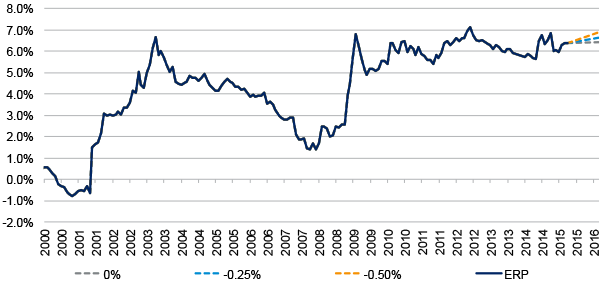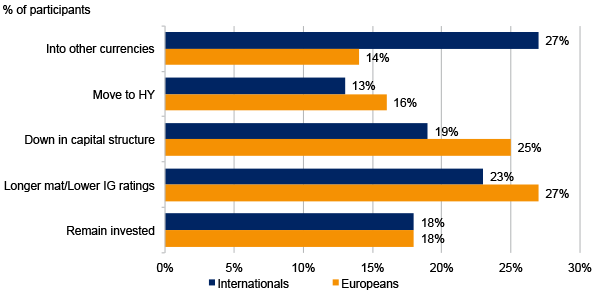
Schroders: The impact of negative interest rates on markets
The latest insight from our multi-asset team examines the effects of negative interest rates on various participants in equity and bond markets.
24.04.2015 | 10:45 Uhr
Perhaps the most direct way to examine the impact of negative rates on equities is through the discounted cashflow model (DCF). This allows us to estimate the intrinsic value of a stock by summing up the present value of all expected cashflows over the life of the security, discounted by the appropriate interest rate. Ceterus paribus, a lower risk-free rate should boost the present value of equities via a mechanical adjustment of valuations upwards. We believe that this phenomenon will be seen most clearly in Europe, where negative interest rates are creeping across sovereign bonds of all shapes and sizes in the region; the chart below illustrates the impact of negative interest rates on our measure of the equity risk premium for Europe.
Figure 1: European equity risk premium (the required rate of return versus cash)

Source: Datastream. Based on MSCI Europe ex UK. Projected ERP based on constant Required Rate of Return for equities minus the adjusted risk free rate.
In addition, the opportunity cost of holding excess cash will motivate corporations to pursue shareholder-friendly activities like buying back shares. Share buybacks are already widespread in the US and we expect this to lift off in Europe over the next few months, which at the margin is supportive for equity prices. On the other hand, negative rates unfortunately also have adverse implications; we believe they are a symptom of being in a low growth environment and future cashflows will need to be marked down accordingly. The reality is that the long-term returns for equities will be lower than we have seen historically.
Let’s now examine the potential medium-term effects of the ultra-low interest rate scenario in the eurozone on three different stakeholders active in the credit markets:
The issuers
Barring the scenario of the credit premium itself turning negative, there are three main consequences that we can expect to affect the overall supply of credit:
a) An incentive to increase leverage either for a further deployment of today’s capital or as a pre-emptive strike against less favourable future issuance.
b) An incentive to restructure maturing debt towards longer maturities (leverage neutral, tenor extension).
c) A cross-border incentive to issue in euro (separately hedging the currency risk) for overseas corporates.
The investor
The European Central Bank’s planned eurozone government bond purchases (as part of its quantitative easing – QE – programme) are much higher than the net supply coming to market. As such, it is possible to speculate that swathes of investors will be displaced.
Whilst it’s hard to make explicit forecasts about the magnitude of potential flows, a recent macro survey showed that a large portion of existing owners of European investment grade credit were already considering a combination of overseas rotation and shift to lower-rated assets.
Figure 2: Barclays GM survey: Intentions of EUR IG investors

This process could then evolve in two directions:
a) The distortion of investors’ natural risk habitat to become driven by loss aversion may create the premise for heightened volatility in the future.
b) The creation of sizeable cross-border carry trades which by nature are destabilising for the global financial system.
The regulatory considerations
There are two potential implications of the recent QE policy intervention:
a) A lack of available collateral (a counterparty owing collateral may have difficulties in finding credit-worthy paper to deliver) could further depress nominal bonds yields.
b) Risk/pricing models of large financial organisations that are typically built on the assumption of positive interest rates may no longer be valid, and may cause mispricing of risks.
An environment of negative yields force investors to shift their asset preference, leading to a strengthening of the ongoing hunt for yield. It can sow the seeds for future instability by distorting the natural price discovery played by market participants. Portfolio rebalancing flows (euro investors moving to overseas assets in an attempt to increase their yield pick-up) and potential further increase in foreign issuance in the euro credit market would be the market dynamics that are worth monitoring.



Diesen Beitrag teilen: